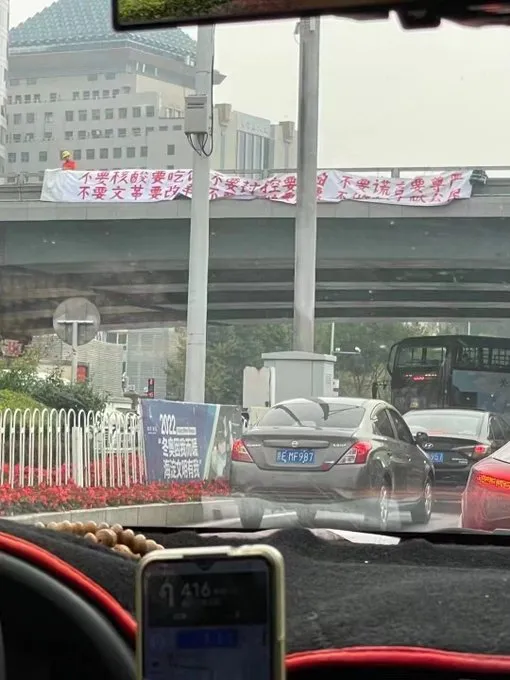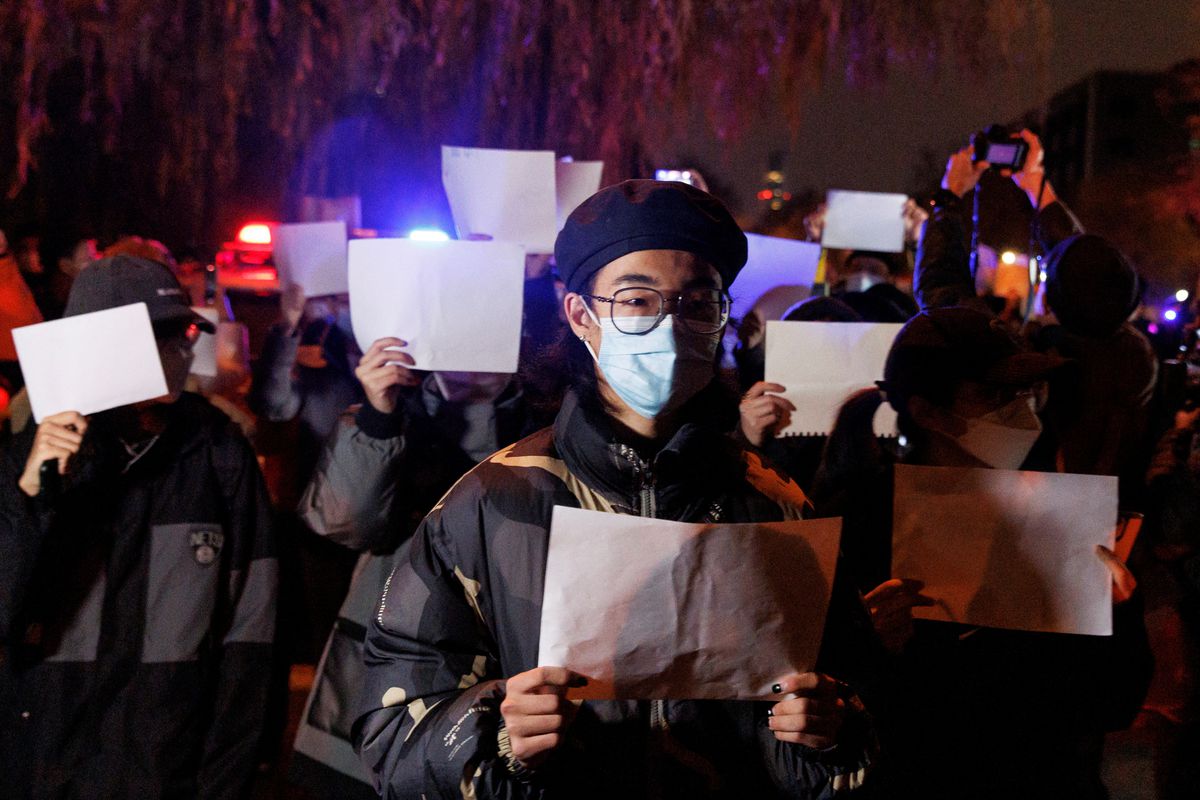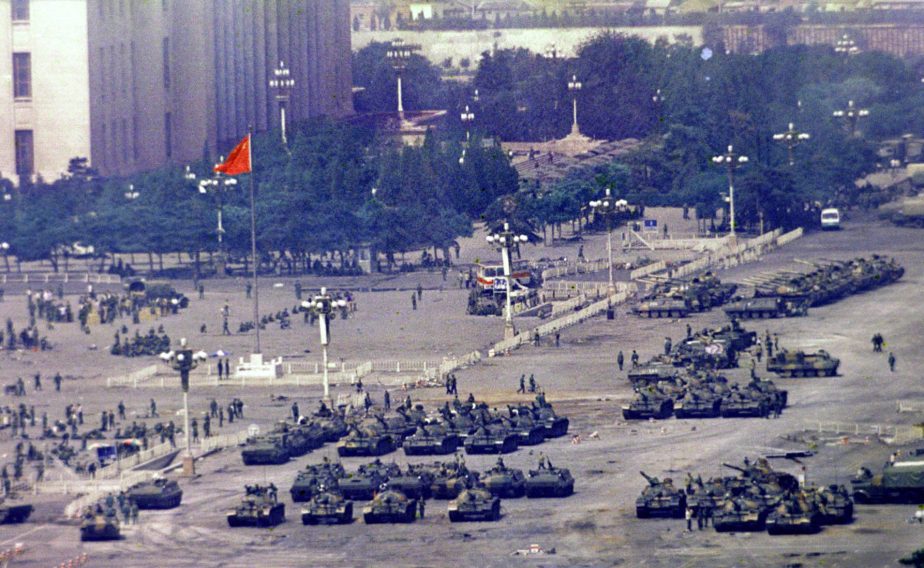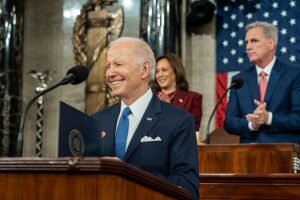China’s Political Awakening Amidst Zero-COVID
If there is one thing to take away from this civil unrest, it is the flaw of a political system where an insufficient public debate has made it difficult to adjust and adapt policies in the face of changing circumstances as other liberal democracies have done. It unveils the weakness of a political system that is ruled by an autocrat whose unchallenged decision-making is a recipe for fatal mistakes. It uncovers the shortcoming of a political system whose ability to act more swiftly, unburdened by the checks and balances of democracy, is paradoxically its own undoing.

Image Credit: AP Photo / Ng Han Guan
For three years, the CCP’s zero-COVID policy in the aftermath of the Wuhan outbreak has included mass lockdowns, excessive testings, heightened surveillance, isolation, quarantines, and border closures. For three years, the CCP has managed to justify the policy by broadcasting how they were able to hold the virus at bay during 2020 and 2021 and how they kept excess deaths to low levels while marginally revitalizing China’s economy after an almost 7 percent sharp decline in GDP.
But the CCP can only keep up this deceit for so long before the Chinese people get fed up with continual announcements of easing restrictions whilst ever more preposterous responses take place. They can only lie for so long before the people — even the younger generation who grew up under heavy party indoctrination — begin to experience a political awakening and are faced with the stark reality that the likelihood of their lives returning to normalcy will not happen unless they do something about it. And now, they are doing something about it. Starting on November 26, anti-government protests erupted in major cities on a scale not seen since 1989’s Tiananmen massacre, according to CNN.
These protests are the latest stage in a snowball effect that started in September when a bus carrying travelers from the locked-down city of Guiyang to a quarantine camp crushed and killed 27 people. As news of the crash emerged, Chinese social media exploded with fierce debate about whether the country’s COVID policies were to blame. Users asked whether the passengers had needed to be transferred at all. But it was not long before the government’s censorship apparatus scraped the internet clean of the news and the debate.
Then came October 13, three days prior to the Party Congress in Beijing where President Xi Jinping secured an unprecedented third term as China’s top leader. An activist named Peng Lifa took to Beijing’s prominent Sitong Bridge and hung banners displaying a daring message in bold red letters: “We want to eat, not do coronavirus tests; reform, not the Cultural Revolution. We want freedom, not lockdowns; elections, not rulers. We want dignity, not lies. Be citizens, not enslaved people.”

The mounting dissatisfaction from Chinese citizens continued to grow as social media footage showed residents under COVID lockdown in China’s southern manufacturing hub of Guangzhou tearing down barriers intended to confine them to their homes and taking to the streets in defiance of strictly enforced local orders in early November.
Afterward, on November 23, hundreds of workers at Foxconn, an iPhone factory in Zhengzhou, marched to protest the factory’s plan to delay bonus payments that were promised in their employment contracts. Coupled with that was the build-up of frustration over the country’s ultra-severe COVID regulations that instruct the Apple Inc supplier to impose a so-called closed loop system that requires workers to live and work on-site, isolated from the wider world. Footage shared on a live-streaming site featured some workers shouting, “Defend our rights! Defend our rights!” Others voiced their discontent over strict quarantine rules, the company’s inability to prevent outbreaks, and poor conditions including shortages of food and filthy dormitories.
Even more so, the timing of the Qatar World Cup is also revealing. In live broadcasts, Chinese citizens witnessed huge crowds coming together and celebrating — maskless — in stadiums, completely contradicting the CCP’s COVID narratives. An open letter questioning the country’s policies and asking if China was “on the same planet” as Qatar spread like wildfire on WeChat before censors removed it from the platform. China’s state broadcaster has since resorted to cutting close-up shots of maskless fans at the World Cup after early coverage sparked anger at home.
The final straw was an apartment fire that killed 10 people on November 24 in Urumqi, the capital of the Xinjiang Uyghur Autonomous Region. Much of the city’s four million people had already been in lockdown for 100 days, and residents were not permitted to leave their homes when the fire engulfed the apartment tower. The building’s fire-escape doors were reportedly locked from the outside and online posts suggested that firefighting efforts were hindered due to COVID restrictions.
This prompted an outpouring of 300 angry people that gathered in Shanghai on November 26. On a street named Urumqi, one group of protesters brought candles, flowers, and signs honoring those who passed away in the blaze, whereas another group was more active in shouting slogans, singing the national anthem, and even calling for President Xi Jinping to step down. Some just stood there holding up blank sheets of paper that quickly turned into the symbol of the protests. China is infamous for swiftly banning words from social media that offend the Communist Party, so the blank sheets have become a loophole that allows protestors to express their indignation without alerting automated censorship tools. Or as one protestor told Reuters, “The white paper represents everything we want to say but cannot say.”
The following day, the scene became violent. Hundreds of police were deployed to break up the demonstration. One of the protesters said that he saw people being taken away and forced by police into vans, but he could not identify them. In the meantime, mass demonstrations spread to Beijing, Chengdu, Guangzhou, and Wuhan, where thousands of Chinese people called for not only an end to COVID restrictions, but more notably, political freedoms. Residents dismantled barricades used to seal off their neighborhoods, took to the streets, and brawled with police in white protective suits. Some protests also took place on college campuses including Peking University, Tsinghua University in Beijing, and Communication University of China, Nanjing.
In light of the nationwide outcry against the draconian lockdowns, it has somehow united Woke Twitter and the CCP apologists—who usually have very different political standpoints—in supporting the harsh rules as necessary for protecting the people against the virus and accusing those who are against the restrictions as deniers of science. The Washington Post journalist Taylor Lorenz wrote on her Twitter that “choosing not to kill off millions of vulnerable people (as the US is doing) isn’t a ‘critical flaw’” in response to The Washington Post’s tweet about how a new wave of the virus outbreak in China has exposed a critical flaw in Beijing’s zero-COVID strategy.
However, this argument about protecting the people is both ludicrous and weak because the implementation of the zero-COVID policy, in the absence of sufficient vaccination and boosting of the elderly and others, does not solve the root of the problem. When it comes to the Omicron subvariant, its infectious nature outstrips China’s controls and defies mass testing, isolation, and closed borders, leaving much of the country stuck in a cycle of outbreaks and lockdowns with no way out. The government’s reach for an ever more extreme approach will only create higher—not lower—danger for vulnerable populations. Meanwhile, having hundreds of healthcare workers committed to testing and quarantine mandates leaves far fewer staff available to administer vaccinations.
Most importantly, vaccination rates for the elderly in China are significantly lower than in the US and UK. Chinese National Health Commission data indicates that only 40.4% of people over the age of 80 had received two jabs plus a booster by November 2022. Additionally, its 1.4 billion people still do not have access to effective coronavirus vaccines. The efficiency of Chinese vaccines has been in doubt since they use a century-old method of working with an inactivated virus to trigger a response by the immune system, as opposed to the mRNA method. Last spring, the CCP stated that it would approve the BioNTech vaccine, a German mRNA shot made in partnership with Pfizer. Then, months later, the Chinese government said that it was close to producing its own mRNA vaccine as well. But neither one of them is available in the country today. According to The New York Times, China succeeded in developing its first mRNA vaccine through the company Walvax in September this year. Although it is authorized to administer in Indonesia, it has yet to be approved in its own country.
With Xi Jinping as president, China has become more isolated and focused on demonstrating self-reliance and promoting domestic development in technology. The refusal to recognize a foreign mRNA vaccine appears to be predicated on nationalist grounds. The CCP is so obsessed with competing with the West on science and technology that it would rather have the entire country in lockdown than approve a readily available foreign option of the mRNA vaccine. In an ironic sense, the Communist Party’s attempt to cultivate national pride is the very thing that caused this nationwide insurgence.
“The mass protests represent the biggest political crisis for Xi,” Minxin Pei, editor of quarterly academic journal China Leadership Monitor, told The Wall Street Journal. “It’s the first time in recent decades that protesters from a broad coalition of social groups have mounted a direct challenge to both the top leader himself and the party.”
President Xi is now at a crossroads in his leadership. He can either lift the zero-COVID policy or double down on regulations that have strangled the country’s economy over the past three years. Neither one of these choices is good for a regime that is fixated on stability. “Xi’s leadership is in a bind. If they compromise and relax zero-COVID, they fear it will encourage mass protests. If they repress more, it will create wider and deeper grievances,” said Yuen Yuen Ang, a political scientist focused on China at the University of Michigan.
Seventy-three years into the CCP’s rule, millions of people lived in the mirage that promised material comfort and convenience and projected political unity and strong nationalism. They lived in the mirage that China strode triumphantly and was unstoppable. That mirage is beginning to clear up now after their cities have undergone repressive lockdowns for three years. Nonetheless, it cannot be said for certain that these emerging protests will fundamentally make a difference in China’s tyrannical political order. The more likely result will be Beijing blaming incompetent local officials who are consistently the top government’s scapegoat. Moreover, under President Xi’s reign, civil society in China lacks independent centers of public morality, organizational networks, and competent leadership. For one thing, most of the protests we have seen so far are haphazard, uncoordinated, and most likely fleeting.
In the wise words of George Orwell: “All tyrannies rule through fraud and force, but once the fraud is exposed, they must rely exclusively on force.” The ongoing turmoil and the seismic political awakening in China illustrate that the party’s fraud has been exposed. What many people are concerned about now, however, is the possibility that these demonstrations will turn into another Tiananmen massacre, and they are right to be. The international community, specifically the Biden administration and other Western governments, ought to give explicit warnings to China about the consequences if any bloodshed is to occur. They ought to leverage Beijing with economic sanctions, more aid for Taiwan, and a clampdown on any offshore assets that belong to China’s top political families. They ought not to let history repeat itself—the history where the United States and other democracies made little effort to deter the former CCP leader, Deng Xiaoping, from killing student protesters in 1989 because they did not think he would do it. They ought not to underestimate Xi Jinping’s and the CCP’s determination to stay in power.
There was a time during the pandemic when Western public-health experts affectionately glanced at Beijing’s zero-COVID policy as an alternative to America’s chaotic democratic process of decision-making to live with the virus after the initial lockdowns. “The Chinese government is to be congratulated for the extraordinary measures it has taken to contain the outbreak, despite the severe social and economic impact those measures are having on the Chinese people,” said World Health Organization Director-General Tedros Adhanom Ghebreyesus in January 2020, a week after the lockdown was implemented.
But if there is one thing to take away from this civil unrest, it is the flaw of a political system where an insufficient public debate has made it difficult to adjust and adapt policies in the face of changing circumstances as other liberal democracies have done. It unveils the weakness of a political system that is ruled by an autocrat whose unchallenged decision-making is a recipe for fatal mistakes. It uncovers the shortcoming of a political system whose ability to act more swiftly, unburdened by the checks and balances of democracy, is paradoxically its own undoing. Honest discussion within democratic rule might slow the decision-making process, but it guarantees that diverse views are heard to avoid such ill-considered decisions from being made.
The core lesson here is that authoritarian regimes are not archetypes of public health or any other public policies that too many Americans imagine them to be. After the upheaval of the Second French Revolution in 1830, Alexis de Tocqueville looked to America and called our early democracy “the great experiment.” Similarly, amidst the upheaval of civil unrest in China, I am reminded of the resiliency of American democracy that has endured the challenges of every stage of this nation’s journey. The fact that we can return to normalcy while China is still trying to lock up its citizens proves that our government is built on an ingenious foundation of principles and laws, and although the people within that system are fallible, the system itself is devised to withstand anything, even an unprecedented pandemic. We ought to acknowledge that and welcome this Chinese insurgence for the same freedom that we have here.
Jay Sophalkalyan, a Cambodian writer, previously served as the Deputy Editor-in-Chief at JPI online magazine. Currently a graduate student at NYU’s XE: Experimental Humanities, his academic pursuits center around journalism and political theory/culture. His research delves into the profound influence of the digital era on journalism, exploring its pivotal role in shaping political culture and philosophy. Jay extends his expertise as a contributing writer for Quillette magazine, showcasing a commitment to thoughtful analysis and insightful commentary in the evolving landscape of societal discourse.







